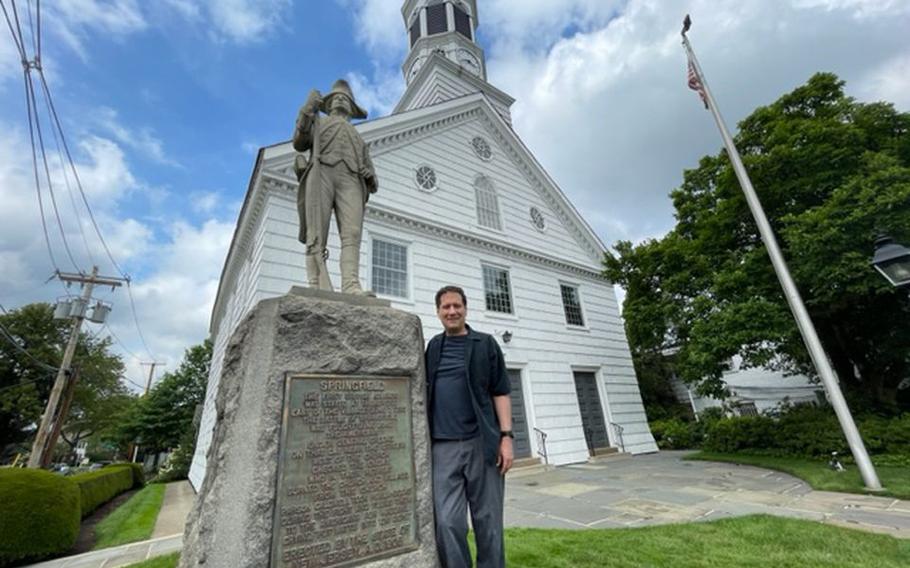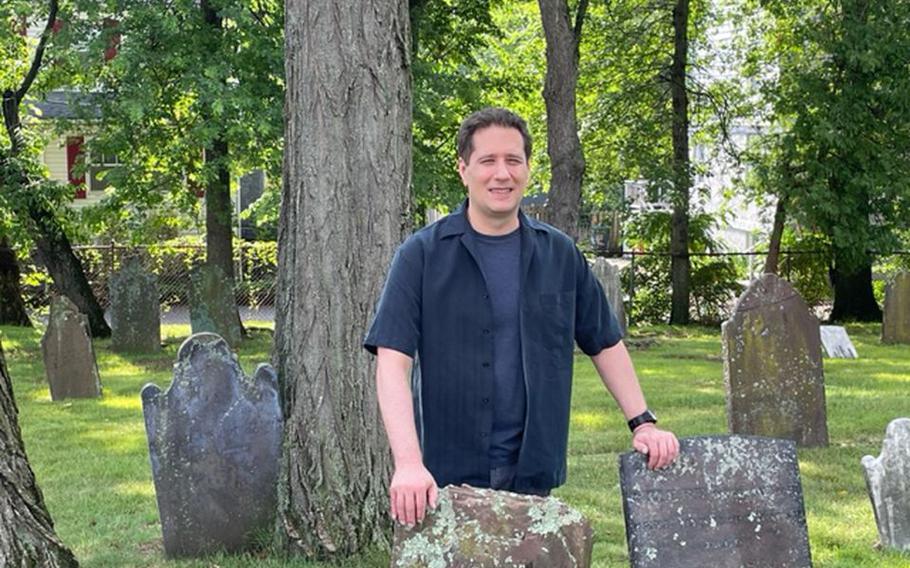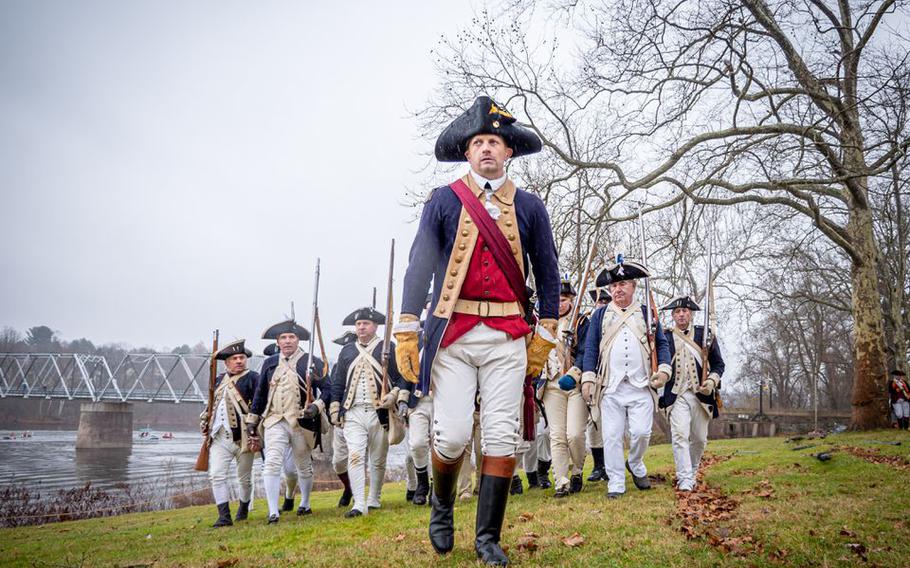
Al Frazza at the Presbyterian Church in Springfield, one of the 650 Revolutionary War sites he visited to create his website. (Richard Cowen, nj.com/TNS)
(Tribune News Service) — Whenever people want to learn about any of the 650 Revolutionary War sites scattered throughout New Jersey, they can turn to Al Frazza and his trusty website in a minute’s notice.
Frazza, a web designer from Little Falls, spent nearly eight years visiting every known Revolutionary War site in a state that has been dubbed “The Crossroads of the American Revolution.”
In roughly the time it took for the Continental Army to defeat the British, Frazza crisscrossed the state with a camera he borrowed from his mother and photographed each site. Then he dug through historical records to create revolutionarywarnewjersey.com, a virtual road map of the small state’s outsized role in the War of Independence.
“I always wondered why, with so much history all around us, that people didn’t seem to appreciate more,” said Frazza, 54, who grew up in Nutley. “I basically said to myself, ‘you keep complaining about this, why not do something about it?’”
So, in September of 2009, he got in his 1988 Buick Century and drove to the John Holcombe House in Lambertville for his first stop. The Holcombe House is one of the many places where George Washington stayed during the war.
Frazza was driving a 1994 Oldsmobile Cutlass Ciera when he finished his project in February of 2017 with a visit to the Kingsland Manor in Nutley, his hometown.
“I’m not really a ‘car guy,’ ” he said. “I have no mechanical ability at all.”
But he knows how to design a website, and took on the often tedious task of sifting through primary source documents. In eight years, he visited all the major sites — like battlefields in Trenton, Princeton, Monmouth, and Springfield — and all the obscure ones, including Turtle Gut Inlet, Aquackanonk Landing, and John Hart’s Cave.
“What I came to realize is that doing historical research is often lonely,” he said. “You’re sitting in a library or a church office, combing through archives. My most constant companion was George Washington. I went to so many locations he was associated with, he was constantly in my life. It never got boring.”

Al Frazza in the cemetery of the Presbyterian Church in Springfield, where at least 31 soldiers who fought in the American Revolution are buried. The Continental Army fought the British at Springfield in 1780. (Richard Cowen, nj.com/TNS)
These days, there’s a lot of traffic on those crossroads, so finding the historic places within the labyrinth of highways, strip malls, farms and factories took up most of Frazza’s free time. He estimates that he spent 10,000 hours on the project.
“I used Google maps and still got lost,” Frazza said. “I would get stuck in traffic. And I was at the mercy of the documents when it came to research. What I came to realize is that everything took a lot longer than I anticipated.”
The British army occupied New York City throughout the war, while the newly-formed Continental Congress set up shop in Philadelphia. New Jersey was in between them and thus became the crossroads, with major battles fought at Trenton, Princeton, Monmouth, and Springfield, and skirmishes, massacres and raids all over the state.
The revolution left its mark — and its markers — all over New Jersey. One of Frazza’s favorite memories is the day he went to the Cherry Hill Mall in search of the white boulder that marked the spot where the Marquis de Lafayette camped on his way to the Battle of Gloucester in 1777. He found the boulder by the entrance to Macy’s.
Then came the day he visited the Proprietary House in Perth Amboy, where William Franklin, the son of Benjamin Franklin, served as the last Royal Governor of the State of New Jersey. William Franklin was arrested just days before his father signed the Declaration of Independence in Philadelphia on July 4, 1776. William eventually returned to England, but he never reconciled with his father, who died in 1790.
The website tells the stories of the heroes and villains of the war. In one dramatic tale, a Presbyterian minister, James Caldwell, tore out of the pages of his church hymnals and gave them to Continental Army soldiers to stuff their muskets with wadding during the Battle of Springfield. (A musket stuffed with wadding will fire more accurately).
Tragically, both Caldwell and his wife, Hannah, would die by the bullet. Hannah was killed by a British soldier during the Battle of Connecticut Farms (now Union) on June 7, 1780. The incident is commemorated on the Union County seal, but officials recently considered changing the seal to remove the depiction of a woman being murdered.
James Caldwell also met a grisly end, shot dead by an American sentry, James Morgan, in 1781. Morgan went on trial for murder at the Presbyterian Church in Westfield and was found guilty. A plaque on Gallows Hill Road in Westfield marks the spot where he was hanged.
Frazza said his favorite moment came in Cranbury, a town in Middlesex County that was the site of a Continental Army encampment in 1778. He remembers being alone on the street on a crisp late Autumn morning, and for that moment Cranbury seemed as it was on the day American soldiers marched into town.
“It was like the place was frozen in time,” he said. “The moment was perfect. I’ve never gone back there, and I never will.”
Frazza recently wrote a book about his journey through New Jersey called “State of Revolution.” He describes the book as “part history, part memoir” and wrote it on a manual typewriter that his mother had in her basement. With the 250th anniversary of the signing of the Declaration of Independence just three years away, Frazza is hoping people will use his website as a guide.
“One of the things that really makes me happy is when people say, ‘Wow, I didn’t know that happened here.’ That was kind of my goal. I didn’t expect to turn everyone into a history fanatic. I just wanted to give people a connection to the past.”
©2023 Advance Local Media LLC.
Visit nj.com.
Distributed by Tribune Content Agency, LLC.

Men dressed as Revolutionary War soldiers march towards boats ready to cross the Delaware River during a Washington Crossing reenactment in Washington Crossing Pennsylvania on Sunday, December 11, 2022. (John J. LaRosa, nj.com/TNS)